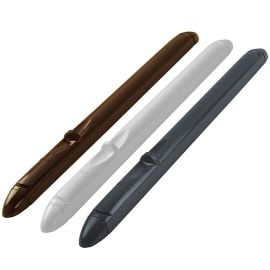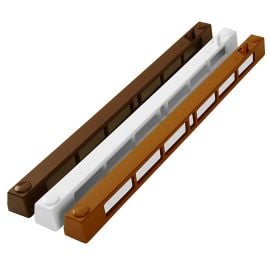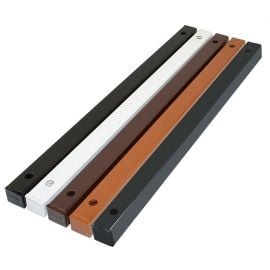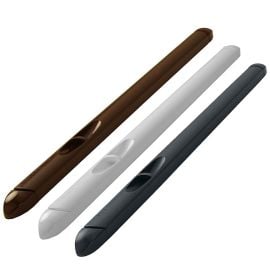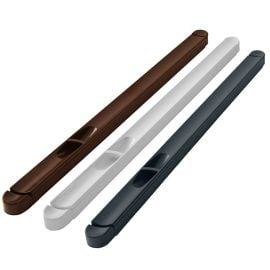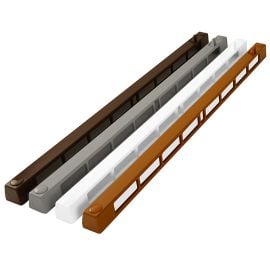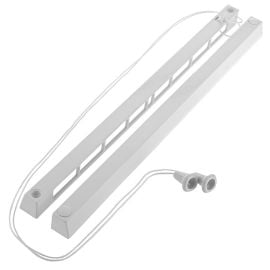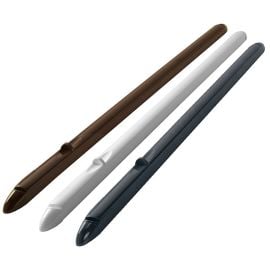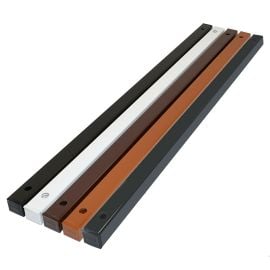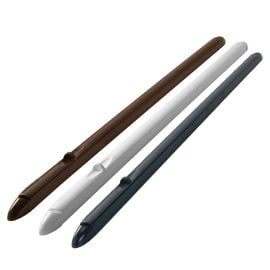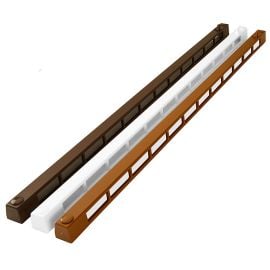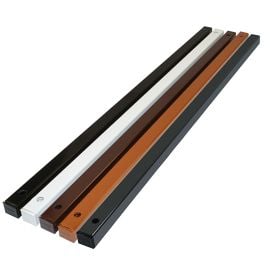Are the internal window trickle vents supplied with the external canopy?
Some do and some don't but you can identify a pair or a singular trickle vent from the picture and its product details. However, the website allows you to select the correct matching canopies or trickle vents and to order them at the same time.
What do I need to know before replacing a window trickle vent?
You need to ensure that the size of the new trickle vent is compatible with your old vent and/or the slot underneath the vent. The best way to check this is to take the existing vent off the window. Vents are usually attached by a series of small lugs that clip-fit into a slot or by two fixing screws. If the vent is clip-fixed you will need to carefully rock and prise the vent away from the slot.
When you take the existing vent off the window you will see a slot or two slots cut through your window.
Measure the slot length and width (if two slots then measure the complete span across both including the middle part). The width will be quite narrow but ensure that you measure it accurately. Then compare the sizes against our guide How To Fit Trickle Vents which tabulates all the vents on the website into size order.
Each of the window trickle vents shown on the website have a series of drawings with sizes to help you find the correct vent.
Check the following:
- The width of your slot against the ‘to suit frame slot size of …’
- The overall length of the slot against the screw fixing points size (ensure there is enough room past the slot at each end to get a screw into the frame.
- The overall length of the vent fits onto the window or opening sash.
How do I fit the new trickle vent?
Initially just offer the trickle vent up to the slot on your window and check the vent actually covers the slots and sits flush onto the frame.
Handlestore only supply vents that can be screw fixed onto your existing frame. You may have screw-fixing points already that can be re-utilised, or it is more likely that you will have to drill two new holes. Drilling into a plastic frame is easy but you need to ensure that you have marked the position of the fixing points carefully. The best way to do this is to hold the vent in its position and then drop a pencil into the fixing holes to make a mark. All of our vents are provided with the correct screws for uPVC frames but you will need to use a 2mm drill for the screw to tighten correctly.
It is recommended that you screw the vent down into position using a hand screwdriver not a drill or any other mechanically/electrically operated device. The screws will appear quite tight but this is important to cut a suitable thread into the plastic. Provided you don’t over-tighten the screws the vent will be adequately fixed.
All vents are provided with two cover caps to disguise the screws and finish off the installation by simply pushing into place.
Can I fit trickle vents to windows without any ventilation?
You can retro-fit these ventilators as long as you are confident with your DIY skills.
The windows you have will require slots cutting through them that are the correct dimensions. By drilling holes this will not allow enough air through because of the bridges between the holes.
The website gives a very good indication of the slot tolerances but for more information on all our vents view the guide How to fit Trickle Vents.
The basis of these window ventilators is to pass air through the frame and to do this you will need to form a slot within the tolerances shown. This can be done on uPVC or timber windows but aluminium or steel windows is not advisable. The vents can then be screwed to the frame and operated quite simply.
We should point out that there may also be extra difficulty with uPVC if there is a metal reinforcement section inside the hollow profile of the frame. This can be the case but not always and the metal can be either aluminium or galvanised steel. The metal sections tend to be quite thin but the galvanised surface of steel is difficult to drill through.
There are two options to consider when positioning the vents on your window. The first is to put them on the outer frame of the window at the very top of the window or alternatively to position them at the head of the opening window itself. The latter may be easier to do as you can take the window off by the hinges and place the complete unit on a table or bench to carry out the work. It is also easier to assess whether any reinforcement is present within the window unit (uPVC) by withdrawing some of the screws to view the screw type. Drill point screws are used for reinforcement metal and self tappers are most likely to be for uPVC only.
Other points to consider:
- Take care to ensure that you are not drilling into the glass unit!
- If you are installing new vents to comply with gas or building regs then please ensure that you are familiar with the requirements for airflow.
My new window trickle vent does not sit down flat onto the frame?
There are several reasons for this.
- The new vent may contain a series of lugs that need to go inside the slot in your window. It is most likely that the new vent is too big for the slot and you need a narrower vent or you will need to slice the lugs off with a sharp knife (Stanley type).
- The new fixing centres are pulling the plastic vent down flat but under tension. Release and re-position carefully.
- The plastic vent is so long it doesn't fit perfectly flat onto the surface of the window. In that case consider the aluminium vents which are more rigid and sturdy.
Should the trickle vent be open all the time on my window?
Yes they should. The purpose of a trickle vent is to provide permanent ventilation into rooms. There are building regulations that cover the exact amount of free flowing air into rooms and these must be maintained. Should you get a gas or carbon monoxide leak these vents could play an important part in saving your life! Trickle vents also help reduce condensation and reduce mould growth caused by dampness.
Handlestore trickle vents are designed to allow for adjustment of the air-flow direction. So to avoid direct drafts you can tilt the vent upwards or downwards as required.
Under no circumstances should you block the vent.
Do trickle vents require any maintenance?
The important thing is to periodically check for any blockage that may occur. The external canopy of the vent is designed to stop insect migration and other foreign matter getting into the vent.
What materials are trickle vents made from?
The trickle vent is a thermoplastic moulding made from a UV stable grade of PBTP (PolyButylene TerePhthalate) and POM (PolyOxyMethylene). This material gives excellent properties in strength and rigidity (with spring like qualities) as well as resistance to wear and organic solvents.
The canopy is made from uPVC and like your windows has excellent weathering properties.
Are trickle vents tested?
Handlestore supply window trickle vents that are made by recognised UK market-leading manufacturers. All of our vents are tested in-house and externally to BS 6375 Part 1 – 1989 – “Performance of windows – classification for weathertightness”





